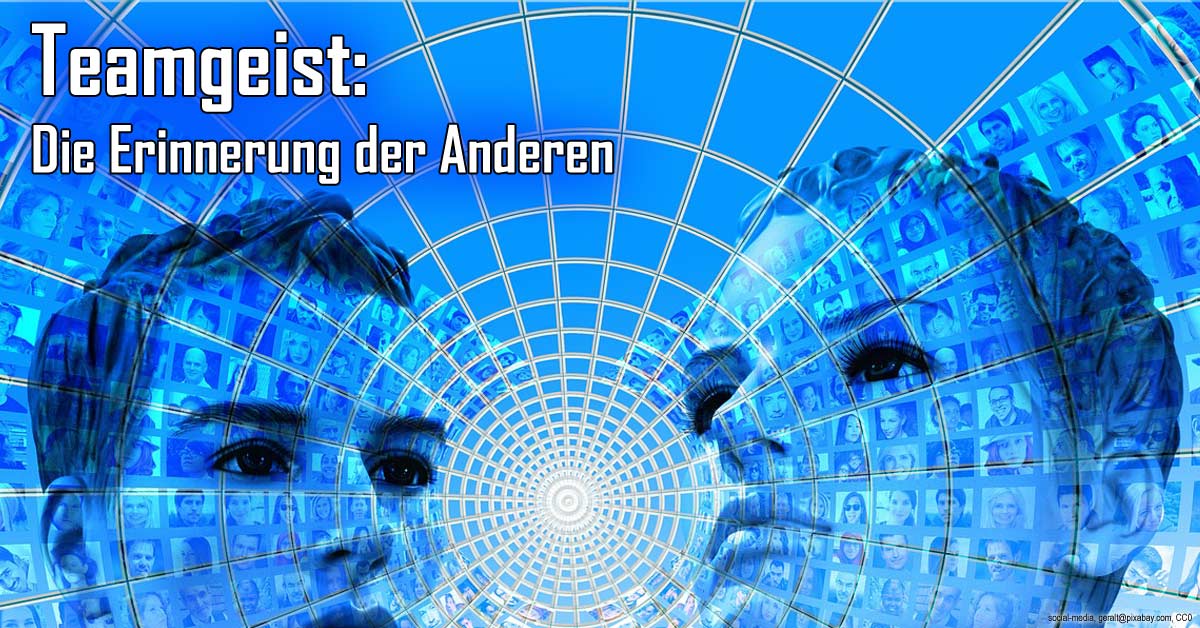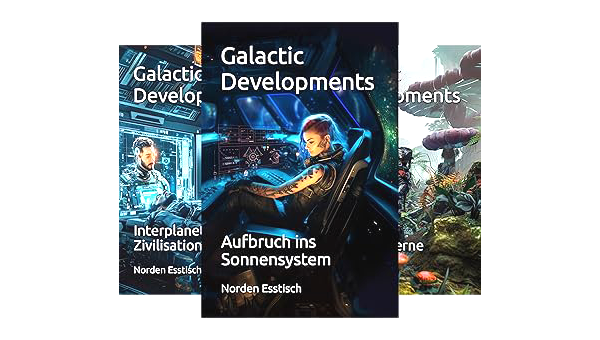
2580 Gruppenassoziation reduziert den Kommunikationsoverhead

Teams können ihre Erfahrungen so verschränken, dass alle automatisch von neuen Erkenntnissen profitieren. Mit Gruppenassoziation verschwinden Kommunikationsdefizite. Accelerated Teams werden noch effizienter.
Wenn mehrere Leute zusammenarbeiten, dann gibt es oft Reibungsverluste durch Informationsdefizite. Nie haben alle Beteiligten den gleichen Wissenstand. Dem begegnet man mit Memos, Berichten und Abstimmungsmeetings in denen Information übertragen wird, oft allerdings nur unvollständig. Die Informationsübertragung ist aber heute nicht mehr das Problem. Das Problem besteht nicht darin, dass Wissen fehlt, sondern es fehlt das Wissen über die Verfügbarkeit zusätzlicher Information.
Fast alle Menschen sind heute per Implantat an digitale Speicher angebunden. Das ist ein mehrstufiges System, von einem lokalen Speicher im Petabyte-Bereich, über den mobilen Anschluss an Wissensdatenbanken bis zur Vernetzung der Erinnerungsspeicher anderer Menschen. Informationen aus dem digitalen Archiv können jederzeit zwischen Menschen übertragen werden, wenn diese das wollen.
Die Schwierigkeit besteht darin zu wissen, dass es zusätzliches Wissen gibt. Wenn man Information suchen und anfordern will, muss man wissen, dass es sie gibt. Ist erst bekannt, dass es eine Information irgendwo gibt, dann bekommt man sie auch. Das Wissen über das Wissen, die Meta-Information, im richtigen Moment an den richtigen Ort zu bringen, ist die Herausforderung bei der Gruppenassoziation.
In der Praxis bedeutet es, dass zu jedem Gedanken relevante Informationen in Datenbanken und bei anderen Menschen gefunden werden müssen. Diese werden dann so in den Denkprozess eingebracht, dass der Vorgang für die Benutzerin wie eine natürliche Assoziation wirkt. Dabei dürfen nicht zu viele Assoziationen erzeugt werden. Der natürliche Denkprozess, bzw. die Denkprozesse der Multitasking-Erweiterung (siehe Ikenga 2491), müssen weiterhin im Vordergrund stehen. Gruppenassoziation soll unterstützen und verbessern, nicht überfordern.
Schon seit langer Zeit werden zusätzliche Gedanken und Ideen über Implantate in den Denkprozess eingespeist. Das fing schon vor Jahrhunderten mit der bewussten Suche im Implantatspeicher an. Mit Wecker- und Erinnerungsfunktionen kamen später erstmals zusätzliche Gedanken an die Oberfläche. Damals noch als einfache Signale. Noch später hatte man Assoziationsbooster, die die spontane Erinnerung an Erlebnisse verstärken und komplexe Gedanken einspeisen konnten. Seit den Multitasking-Erweiterungen des 25. Jahrhunderts sind künstliche Assoziationen auch für mehrere geistige Prozesse verfügbar.
Mit der Gruppenassoziation bezieht man nun Erinnerungen nicht mehr nur aus den eigenen Erlebnissen, sondern auch von anderen Menschen und aus Datenbanken. Das ist technisch viel aufwändiger als einfache Assoziationsbooster, die nur mit den eigenen Erinnerungen arbeiten.
Die ersten Produkte, die Gruppenassoziation realisieren, sind bestimmt für sogenannte beschleunigte Teams (Accelerated Teams) in der Entwicklung, in der Forschung und für militärische Anwendungen. Auch wohlhabende Privatleute, Anhänger von Hivemind und Aufstiegstheorien experimentieren mit Gruppenassoziation.
Die ersten Produkte sind teuer, vor allem wegen der Software, die den Prozess steuert. Um Assoziationen und Gedankenfragmente zwischen Menschen zu übertragen, braucht man viele Verarbeitungsschritte:
- Privatsphäre: natürlich sollen nicht alle Erinnerungen allgemein verfügbar sein. Schon an der Quelle arbeitet deshalb ein Privatsphärenfilter, der private Gedanken und Erlebnisse aus dem Datenstrom löscht, bevor sie überhaupt gespeichert werden. Hier sind verschiedene Profile möglich. Es gibt auch Anwender, die sehr private Gedanken teilen wollen. Aber die üblichen Einstellungen für Arbeitsumgebungen selektieren gezielt nur Arbeitsinhalte.
- Sicherheit: nicht jeder darf alles wissen. Trotz unterschiedlicher Sicherheitsfreigaben sollen Informationen geteilt werden können. Deshalb sucht der Security-Filter im Datenstrom nach sicherheitsrelevanten Erkenntnissen und klassifiziert Informationen.
- Spam-, Mem- und Virenschutz: Ideen, die künstlich eingespeist werden, umgehen die handelsüblichen Mem/Spam-Filter der optoakustischen Implantate. Gruppenassoziationsprodukte müssen aber den gleichen Schutz gewährleisten. Sie enthalten deshalb eigene Komponenten zur Abwehr von unerwünschten Informationen und Ideen. Eine besondere Herausforderung ist die Abwehr von Stealth-Memen, deren zugrundeliegende Idee sich aus mehreren Informationenblöcken zusammensetzt von denen jeder einzelne nicht als Teil eines Mems erkennbar ist. Erst die Assoziation der Informationen ergibt das Mem.
- Rationalität: Gedanken und Erlebnisse sind of fragmentarisch und irrational. Diese Informationen sollen nicht in den Pool der Gruppe eingehen. Deshalb wird die Realitätstreue überprüft und danach gefiltert.
- Relevanz und Priorität: wenn Assoziationen und Informationen von vielen Teilnehmern bei Einzelnen zusammenlaufen, muss das System darauf achten, die Empfänger nicht zu überfordern. Zu viele gedankliche Sprünge und künstlich erzeugte Eingebungen behindern sonst den natürlichen Denkprozess. Deshalb müssen mögliche Assoziationen auf Relevanz überprüft und priorisiert werden. Zusätzliche Informationen sind nur dann hilfreich, wenn sie verarbeitet und angewendet werden können. Die Rate künstlich erzeugter Assoziationen ist individuell einstellbar.
- Konvexität: Assoziationen sind nur dann nützlich, wenn sie zu Informationen führen und nicht zu Informationsdefiziten. Assoziationen sollen genügend Informationen enthalten, um "rund" zu wirken. Unvollständige Assoziationen können verwirren. Der Mechanismus der Gruppenassoziation soll Informationen liefern, nicht zu viele Fragen aufwerfen. Die Konvexer-Komponente vervollständigt Themen, bevor sie als künstliche Assoziationen eingespeist werden.
Gruppenassoziation sorgt dafür, dass alle Mitarbeiter eines Teams intuitiv wissen, dass es relevante Informationen gibt, wenn ein Mitglied des Teams eine Erinnerung daran hat:
- Jeder im Vertriebsteam kennt alle Kunden, die jemals von einem Kollegen kontaktiert wurden.
- Fab-Designer kennen alle Teile-Bibliotheken, die einzelne Mitglieder des Teams kennengelernt haben.
- Mitglieder eines Software-Teams verstehen intuitiv, was andere sich bei Softwarestrukturen gedacht haben.
- Trader eines Investment-Teams in Märkten, wo Reputations- und Kapazitätsbewertungen gehandelt werden, sind immer informiert über alle Meldungen und Gerüchte, die Bewertungen beeinflussen können.
Gruppenassoziation wirkt dem Trend zur Spezialisierung in Accelerated Teams entgegen. Der Scout des Teams muss nun keine Memos mehr senden oder die Kollegen mit Epics teasern. Sein erworbenes Wissen steht automatisch allen zur Verfügung. Alle Mitglieder können ihr Wissen ohne Zusatzaufwand zugänglich machen.
Kollegen können ohne Reibungsverluste die Arbeit von anderen übernehmen. Team-Mitglieder werden austauschbar, da ihr Spezialwissen nicht verloren geht. In Accelerated Teams definiert sich die Führung bald mehr über die Fähigkeiten zur Problemanalyse, die Kreativität und die Beherrschung von Komplexität als über Erfahrung und Detailwissen. Das löst Widerstände aus, denn das Team wird wichtiger als einzelne Mitglieder. Aber auch für den Einzelnen überwiegen die Vorteile in Accelerated Teams. Assoziations-Teams sind wesentlich schneller und werden höher bezahlt als "nur" wissensvernetzte Teams.
Das erste kommerziell verfügbare Gruppenassoziationsprodukt ist TeamSpirit der Haemmerli-Marti G. a. G./Zürich.
Andere Gruppenassoziationssysteme:
- Zweitgeist von Dowwe-Labs/Bloemfontein,
- Mengirimkan von Rabun Dekat PT/Palembang-Orbital/Mars,
- Yidong Ta von Lixing Yanjiu XGdHG/Huayuan Tiankong Cluster im Asteroidengürtel.
Neue Beiträge
2158 Space Patrol
2222 Weltraumpiraten
2326 Kein interplanetarer Krieg
3050 Königliche Garde
3090 Solo Ehre
2234 Am Ende des Orbits
2248 Gemini-Katastrophe
2366 Orbitale Ökonomie
2312 Kaio-Artefakt
3361 Erste Menschheit
2333 Metrische Impulsverstärkung
2337 Verschwörung im Orbit
2247 Quantensprung
2284 Trennung der Erde
2321 Isolation der Erde
2205 Unternehmensnationen
2192 Antiexpansionistischer Terror
2179 Private Asteroidenbasis
2231 Vereinte Planeten
2291 Verbotene Forschung
Die Besten
(20 von 75)
2091 Baum des Lebens
2135 Sonnenschirm für die Erde
2179 Private Asteroidenbasis
2205 Unternehmensnationen
2222 Weltraumpiraten
2231 Vereinte Planeten
2234 Am Ende des Orbits
2326 Kein interplanetarer Krieg
2587 Alien gegen Alien
2630 Verschwörung gegen die Menschheit
2648 Abenteuerliche Reise
2668 Ultrametalle
2720 Spacedom-Tragödie
2743 Kisor's Geschichte
2750 VR-Drama Executive Decision
2806 Weltraum Müll
2841 Leuchtender Tempel
2844 Digitale Entdeckung
3110 Zersplitterung des äußeren Systems
3245 Sterge-Blockade
 2577
Drohung der Artu-Domäne
2577
Drohung der Artu-Domäne

 2583
Die Amaterasu geht mit 3.337 Auswanderern verloren
2583
Die Amaterasu geht mit 3.337 Auswanderern verloren